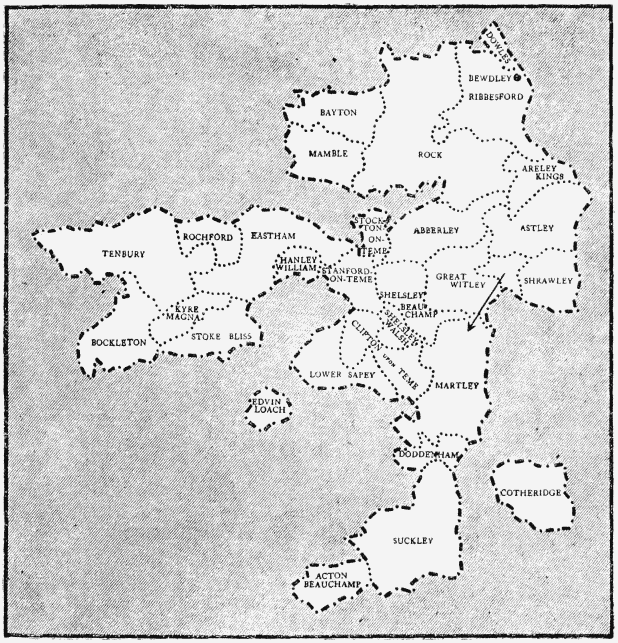A History of the County of Worcester: Volume 4. Originally published by Victoria County History, London, 1924.
This free content was digitised by double rekeying. All rights reserved.
'The hundred of Doddingtree: Introduction', in A History of the County of Worcester: Volume 4, ed. William Page, J W Willis-Bund (London, 1924), British History Online https://prod.british-history.ac.uk/vch/worcs/vol4/pp218-219 [accessed 1 February 2025].
'The hundred of Doddingtree: Introduction', in A History of the County of Worcester: Volume 4. Edited by William Page, J W Willis-Bund (London, 1924), British History Online, accessed February 1, 2025, https://prod.british-history.ac.uk/vch/worcs/vol4/pp218-219.
"The hundred of Doddingtree: Introduction". A History of the County of Worcester: Volume 4. Ed. William Page, J W Willis-Bund (London, 1924), British History Online. Web. 1 February 2025. https://prod.british-history.ac.uk/vch/worcs/vol4/pp218-219.
THE HUNDRED OF DONDDINGTREE
CONTAING THE FOLLOWING PARISHES (fn. 1) :
| ABBERLEY | HANLEY WILLIAM | SHELSLEY BEAUCHAMP with SHELSLEY KINGS |
| ACTON BEAUCHAMP | KYRE WYARD OR KYRE MAGNA | |
| ARELEY KINGS | SHELSLEY WALSH | |
| ASTLEY | MAMBLE | SHRAWLEY |
| BAYTON | MARTLEY WITH HILLHAMPTON | STAINFORD ON TEME |
| BOCKLETON | STOCKTON ON TEME | |
| CLIFTON UPON TEME | RIBBESFORD WITH THE BOROUFH OF BEWDLEY | STOKE BLISS WITH KYRE PARVA |
| COTHERIDGE | ||
| DODDENHAM | ROCHFORD (fn. 3) | SUCKLEY WITH ALFRICK AND LULSLEY |
| DOWLES (fn. 2) | ROCK OR AKA | TENBURY |
| EASTHAM WITH HANLEY CHILD AND ORLETON | LOWER SAPEY OR SAPEY PITCHARD | GREAT WITLEY |
| EDVIN LOACH | ||
The Domesday hundred of Doddingtree (Duddantreo, Dodentreu, Dodintre, Dodintret, Dodintreu, Dudintree) was mainly composed of the holdings of Ralph de Toeni, Ralph de Mortimer, and Osbern Fitz Richard, with the addition of smaller estates belonging to less important landowners. It was stated in the Survey that 20 hides of Doddingtree Hundred lay in Fisseberge (afterwards Blackenhurst) Hundred, having apparently been added to the latter to make up the full hundred hides. (fn. 4) The hundred has not undergone many changes since that time. Eardiston and Knighton in Lindridge, Mathon, and Wychbold and Elmbridge in Dodderhill, which in 1086 were in Doddingtree, have since been separated from it. (fn. 5) The first two belonged to the church of Worcester, and were taken from Doddingtree in 1207, when Lindridge was constituted a separate liberty independent of the hundred court. (fn. 6) Mathon belonged to the Abbot of Pershore and was transferred before 1280 to the hundred of Pershore, which that abbot shared with the Abbot of Westminster. (fn. 7) Wychbold, though it was one of the most important of Osbern Fitz Richard's estates in Worcestershire, had been transferred to Halfshire Hundred before 1280, and Elmbridge was also in Halfshire at that date. (fn. 8)
Cotheridge, which now forms part of Doddingtree, was part of the manor of Wick Episcopi in Oswaldslow Hundred in 1086. (fn. 9) It belonged to Osbern Fitz Richard, and had been transferred to Doddingtree, in which the bulk of his estates were situated, before 1327. (fn. 10) Martley and Suckley, though in Doddingtree Hundred, were surveyed in 1086 under Herefordshire, the reason for this being that they had formerly belonged to William Earl of Hereford and his son Roger, and they had so far annexed them to their lordship of Hereford that they were surveyed under Herefordshire. Stoke Bliss was in Plegeliet Hundred in Herefordshire in 1086, (fn. 11) and remained chiefly in Broxash Hundred in that county until 1897, when it was transferred wholly to Worcestershire. (fn. 12) The hamlet of Hampton Charles in Bockleton has always been in Broxash Hundred.
Towards the latter part of the 18th century the hundred was separated into the two divisions of Upper and Lower Doddingtree. It was also divided into nine towns of oyer for the purposes of raising aids. (fn. 13)
The hundred of Doddingtree has always belonged to the Crown, (fn. 14) though it is frequently returned among the possessions of the Beauchamps, Earls of Warwick, to whom the hereditary shrievalty of the county belonged. (fn. 15)
Doddingtree was situated near Redmarley in the parish of Great Witley, (fn. 16) probably near the spot where the Hundred House Hotel now stands, at the junction of the roads from Tenbury and Cleobury Mortimer to Worcester. The 'Hundred House of Dodyntre' was described in 1697 as 'the Dwelling House of William Leatherland, known by the sign of the Crowne.' (fn. 17) All the parishes in the north and west of this hundred are in the diocese of Hereford.

Index Map to the Hundred of Doddingtree
